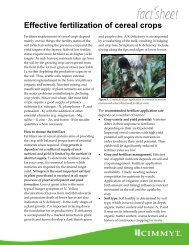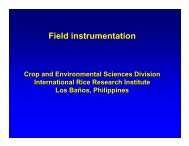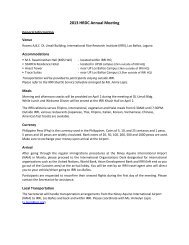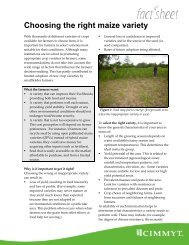Water management in irrigated rice - Rice Knowledge Bank ...
Water management in irrigated rice - Rice Knowledge Bank ...
Water management in irrigated rice - Rice Knowledge Bank ...
- No tags were found...
You also want an ePaper? Increase the reach of your titles
YUMPU automatically turns print PDFs into web optimized ePapers that Google loves.
Ψ Air–100 MPaDemandLeafXylemStemRootStomatal cavityΨ Leafг StemΨ Rootг Leaf–1 MPa–0.4 MPa<strong>Water</strong> phase Vapor phaseEndodermisг RootSupply<strong>Water</strong> flowSoil particleΨ Soil–0.02–0.1 MPaΨroot – Ψsoil Ψleaf – Ψroot Ψair – Ψleaf= =гroot гstem гleafFig. 2.2 Schematic overview of water flow and water potentials <strong>in</strong> the soil-plant-atmosphere cont<strong>in</strong>uum. Adapted fromLövenste<strong>in</strong> et al (1992).Table 2.2. Some typical soil water tension levels <strong>in</strong> relation to the growth of upland crops (e.g., wheat, maize, cotton).Name pF value ExplanationSaturation –∞ All soil pores are filled with waterField capacity 2 Soil water content that is considered optimum for upland cropsPermanent wilt<strong>in</strong>g po<strong>in</strong>t 4.2 Soil water content at which most upland crops cannot extractwater from the soil any more and show permanent wilt<strong>in</strong>gAir dryness 7 No free water <strong>in</strong> soil pores any moreavailability, soil microbial population, soil organicmatter buildup/decomposition, and occurrence ofsoil pests and diseases (Chapter 3.6). Figure 2.3illustrates soil water tensions measured <strong>in</strong> an aerobicsoil where <strong>rice</strong> was grown under nonfloodedconditions like an upland crop.Each soil has a specific relationship betweenthe tension of the water and the amount of water:the lower the amount, the higher the tension. Thus,a small amount of water <strong>in</strong> the soil and a hightension both reflect a condition of relative “waterscarcity” and drought. The relationship betweensoil water tension and soil water content is calledthe “soil water retention curve” or the “pF curve.”The shape of the pF curve depends on soil type,especially on its texture (mixture of clay, silt, andsand particles), bulk density (the weight of a soilover its volume), m<strong>in</strong>eralogy, and organic mattercontent. Examples are given <strong>in</strong> Figure 2.4 for atypical clay soil and a typical sand soil. There arefour important po<strong>in</strong>ts on the pF curve for uplandcrops: saturation = pF –∞ (H = 0 cm), field capacity= pF 2, permanent wilt<strong>in</strong>g po<strong>in</strong>t = pF 4.2, andair dryness = pF 7 (see Table 2.2). The amount ofwater at each of these four tensions is different foreach soil type. When <strong>rice</strong> fields are flooded, thepF curve is not needed as soil water contents arealways at saturation. However, when a <strong>rice</strong> soil13





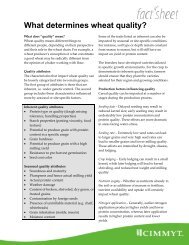

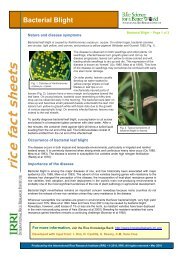

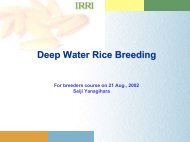
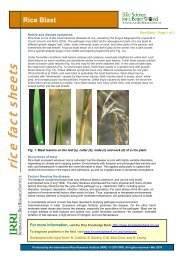
![International Standards' Organization â Rice Specification [ISO 7301]](https://img.yumpu.com/36696862/1/190x245/international-standards-organization-a-rice-specification-iso-7301.jpg?quality=85)

